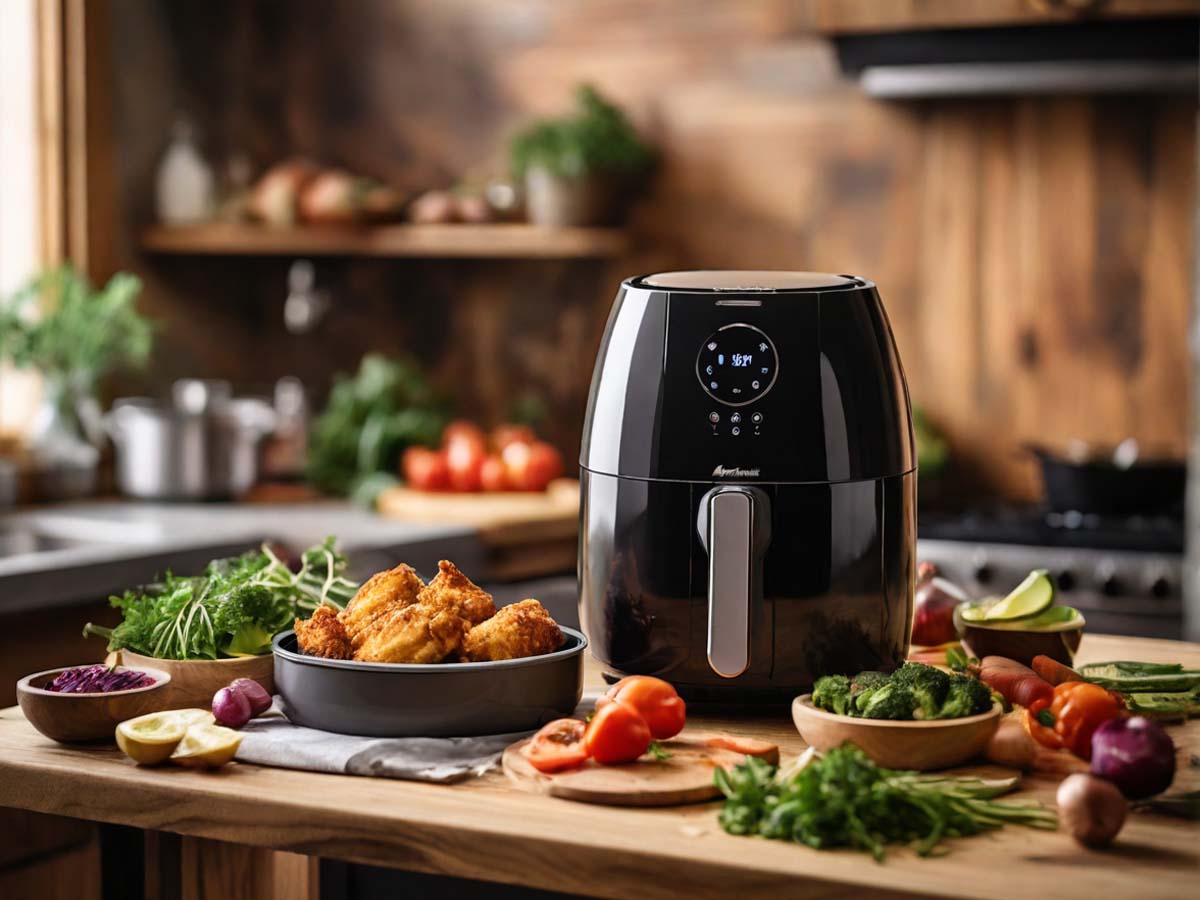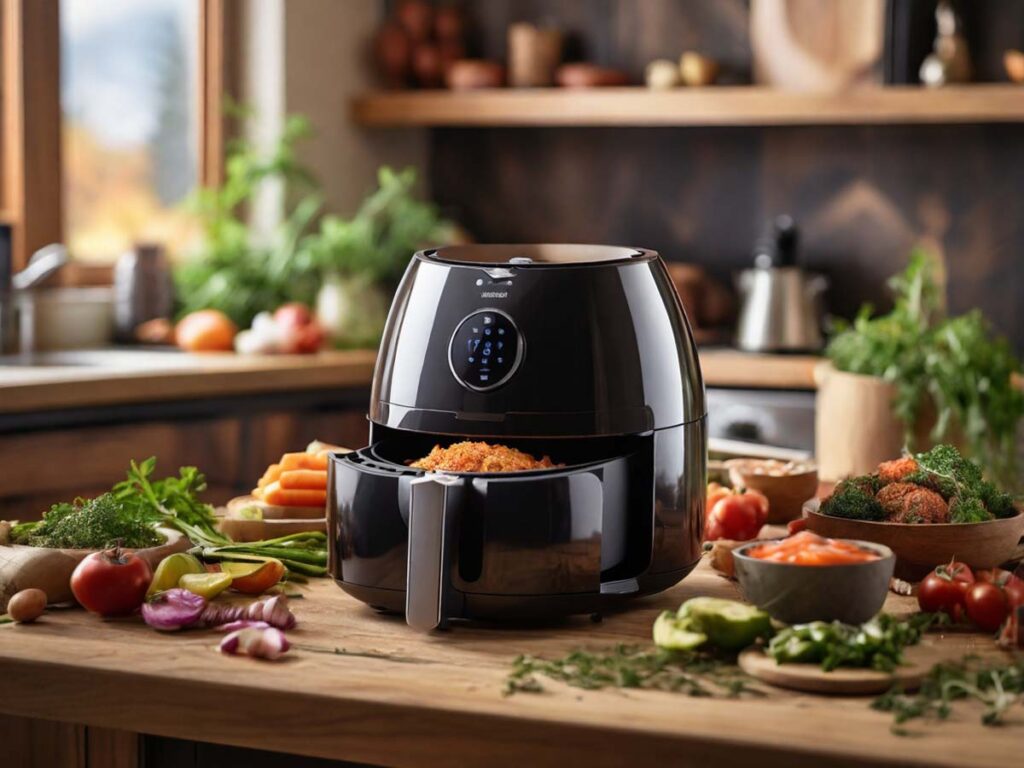Can You Put an Air Fryer on a Wooden Surface? Safety Tips

You can put an air fryer on a wooden surface, but it’s important to use a heat-resistant mat or trivet for protection.
Ensuring air fryer safety involves more than just the convenience of use; it’s about safeguarding your kitchen from potential hazards. Selecting the right surface is crucial, as it must offer heat resistance and stability.
Proper appliance placement not only extends the lifespan of your air fryer but also promotes a safer kitchen environment. When using any cooking appliance, kitchen safety should always be a top priority, especially with heat-generating devices like air fryers.
Understanding Air Fryer Design and Heat Emission
Air fryers operate using rapid air technology, circulating hot air to cook food. This method mimics deep-frying but without the need for excessive oil.
Air fryer mechanics are designed to ensure even heat distribution, making them a versatile cooking appliance.
The heat emission from an air fryer is concentrated upwards and out through its vent. This design helps in efficiently cooking food while minimizing surface heat.
However, the area around the air fryer can still become warm due to this heat distribution.

The Role of Ventilation in Air Fryer Operation
Proper ventilation is key to the optimal operation of air fryers. It ensures air flow around the appliance, aiding in heat dissipation.
Without adequate space for air flow, heat can build up, potentially affecting kitchen surface protection.
Ensuring your air fryer is placed in a well-ventilated area prevents overheating. It safeguards both the appliance and the surface it rests on.
This consideration is especially important for heat dissipation, keeping the surrounding area cooler.
Materials and Heat Resistance
Air fryers are constructed with heat-resistant materials. These include plastic, metal, and sometimes ceramic components.
The material safety and construction quality of these appliances are designed for durability and to withstand high temperatures.
Understanding the heat resistance of these materials helps in appreciating the design and safety features of air fryers.
Such construction quality ensures that, while the appliance gets hot, the exterior remains safe to touch, reducing the risk of burns.
This guide aims to provide a thorough understanding of air fryer design, emphasizing heat emission, ventilation requirements, and material safety.
Ensuring these factors are considered will enhance both the efficiency and safety of using an air fryer in your kitchen.
Can You Put an Air Fryer on a Wooden Surface?
Placing an air fryer on a wooden surface is possible, but caution is advised. Wooden surface safety and air fryer placement are critical to surface damage prevention.
While modern air fryers are designed to minimize heat transfer to their exterior, they can still emit heat that may pose a risk to sensitive surfaces.
Ensuring kitchen counter safety involves understanding how your air fryer operates and the heat it may emit during cooking.
It’s about balancing convenience with care to avoid any potential damage to your kitchen workspace.
Factors to Consider for Safe Placement
When considering an air fryer’s placement on a wooden surface, several factors need attention. Surface considerations include the heat tolerance of the wood and the wooden countertop protection against heat exposure.
- Heat tolerance: Assess the heat resistance of your wooden surface. Some treated or engineered woods may withstand heat better than others.
- Ventilation: Ensure there is ample space around the air fryer for proper air flow, which helps in heat dissipation.
- Safety tips: Use a trivet or heat-resistant mat under the air fryer to act as a barrier, protecting the wood from potential heat damage.
These considerations help in making an informed decision regarding air fryer placement and ensuring the longevity and safety of both the appliance and the kitchen surface.
Alternatives to Wooden Surfaces
If concerns persist about placing your air fryer on a wooden surface, consider alternative surfaces or protective accessories. Heat mats and silicone trivets offer excellent countertop protection, absorbing much of the heat before it can reach the wood.
Alternative surfaces might include granite, tile, or metal, which naturally resist heat better than wood. If these options are not viable, protective accessories like heat-resistant mats or boards can provide a safe and effective solution.
Employing these measures can ensure the safe use of your air fryer without compromising the beauty or integrity of your wooden surfaces.
This approach allows you to enjoy the convenience of air frying while maintaining kitchen counter safety.
To know more: Does the Cosori Air Fryer have Teflon
Maintenance and Care for Longevity
Proper placement is a pivotal aspect of air fryer maintenance that directly influences the appliance’s longevity. Adhering to longevity tips and establishing a consistent care routine can significantly extend the life of your air fryer.
The placement impact is not just about preventing physical damage; it also involves ensuring the appliance operates under optimal conditions, free from overheating risks and with adequate ventilation.
Regular Inspection and Cleaning
A thorough cleaning routine is essential for maintaining your air fryer’s efficiency and safety. Incorporating an inspection checklist into your care routine helps identify any issues that could escalate into safety hazards.
Regular safety checks ensure the appliance and its surrounding area remain free from debris that could obstruct vents or air flow, posing fire risks or affecting performance.
- Cleanliness of both the air fryer and its environment prevents the accumulation of grease and food particles, which can attract pests or become a source of unpleasant odors.
- Ensuring the area around the air fryer is clean also protects your kitchen surfaces from heat or grease damage.
Recognizing Signs of Wear and Tear
Being vigilant about wear indicators and damage signs is crucial for both the air fryer and the wooden surface it rests on. Maintenance alerts can come in the form of unusual noises, reduced performance, or visible damage to the appliance’s cord or exterior.
- Safety precautions include monitoring for discoloration or warping of the wooden surface beneath the air fryer, which might indicate heat damage.
- Regularly checking for these signs helps in taking timely action, whether it involves adjusting the placement, enhancing ventilation, or replacing worn components.
Proactive maintenance and care are indispensable for preserving the functionality and appearance of your air fryer and kitchen.
By following these guidelines, you can enjoy the benefits of air frying while ensuring a safe and efficient cooking environment.
Ensuring Air Fryer Safety on Various Surfaces
In summary, employing safe cooking practices with air fryers is paramount to kitchen safety. Making informed decisions about where to place your air fryer can significantly mitigate risks of damage to surfaces and ensure the appliance’s longevity.
Kitchen safety summary: Understand air fryer design, heat emission, and the importance of ventilation. Best practices include using heat-resistant mats on wooden surfaces and regular maintenance routines.
By adhering to these guidelines, you can enjoy the benefits of air frying without compromising on safety or surface integrity. Remember, the right placement and care not only protect your surfaces but also enhance your air fryer’s performance and lifespan.
See all in at KitGiz for Knowledge about Air Fryer and Care & Using guides.
